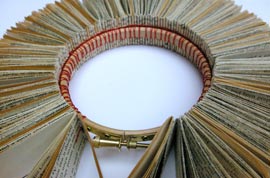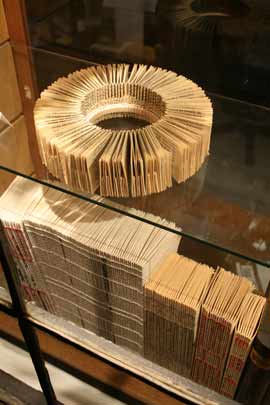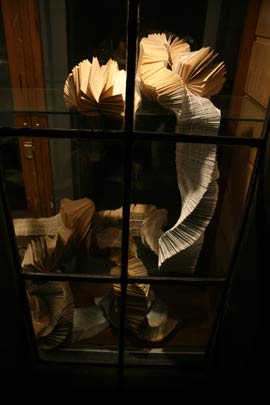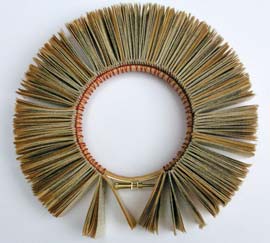Project 4
15th June - 16th July
Yvette Hawkins
All The Books I Have Never Finished
Wonder is intrinsically linked to the visual world. It is described as an all-at-once visual experience, sudden and unexpected. The entire object in all its detail present at once. Narration, involving time can never be present in such an instant. Narrative unfolds in a sequence, determined by the author using syntactic structures and grammatical expectations. By contrast, wonder is instantaneous.
'We first take in the whole. The next step of the experience for any viewer, is to create her own narrative, by looking now at this detail, then at that , changing scale to larger or smaller details, inventing in each experience a self-determined history of attention.'
Yvette Hawkins’ bookish sculptural objects hold in tension different ways of looking; the wonder of glimpsing a defunctionalised object, and the temptation to engage further in what will be a futile attempt to seek comfort in the act of reading, of constructing narrative. The inversion of our traditional approach to text is challenging as ‘the familiar current of experience has shifted to reveal something new: a rich beauty and depth that has emerged from the midst of the familiar’, and it is compelling. The durational demands of reading are subverted by visually graspable formal properties of line and mark making, of the qualities of the paper itself. The sculptural patterning of the page and the blackened lines of the printed word have replaced the rhythmical syntax of prose. Sentences become fragmented words and letters that allude to order but in their new configuration disable our ability to decipher.
The internal workings of ‘text’ are exposed; the linear forms from which words emerge, the surface on which the words rest, and the sewn page sections. The use of traditional binding techniques renders visible their gendered nature, with women charged to undertake the sewing that would be hidden beneath the covering and the finishing carried out by men. The tactile - thumbed and fingered pages, sewn sections – is, however, denied with the bookish objects held behind glass. The combination of oak and glass recalls those often dust-filled glazed library book-cabinets, with their prevailing system of classification determining order and general reification of the knowledge conveyed by the written word. This order to which the objects appeal but evidently disrupt recalls the surrealist passion for ‘Systematic disorder’. The framing of the objects in a pseudo-museum mode, along with the traditional function of text, plays with ideas of knowledge construction and questions the relationship between object and/as text. As Stephen Greenblatt has observed: The experience of wonder was not initially regarded as essentially or even primarily visual; reports of marvels had a force equal to the seeing of them…the great medieval collections of marvels are almost entirely textual.’
The unfinished quality of the sculptures parallels the artist’s relationship with the books and the eternal state of that quest for knowledge. The collection is personal to the artist and, in its indecipherability, belies categorization by the viewer; and yet on to it the viewer can project their neglected paperbacks, those books gathering dust by the bedside table and those that will continue to do so. All the books that I have never finished. And that we will now, never finish.
Biography: Yvette Hawkins graduated from Newcastle University, Fine Art BA in 2007 and has continued to live and work in the North East since. Yvette makes tactile, engaging and textural sculptures and installations which transform everyday useable and familiar materials into objects that explore suggestion and secrecy. Her work is concerned with the physical acts of looking, reading and listening encouraging viewers to consciously be aware of their surroundings, controlling and manipulating the way things can be seen, read and heard. She follows a socially engaged practice which often involves members of the public, who are encouraged to physically interact with the artwork at various stages of the making and presenting of work. She is interested in the notion of memories, the cultural psychologies of looking and the differences between socially conditioned learning patterns and biological ones. This acts as a central theme throughout her practice.
yvettehawkins@gmail.com
www.yvettehawkins.com



